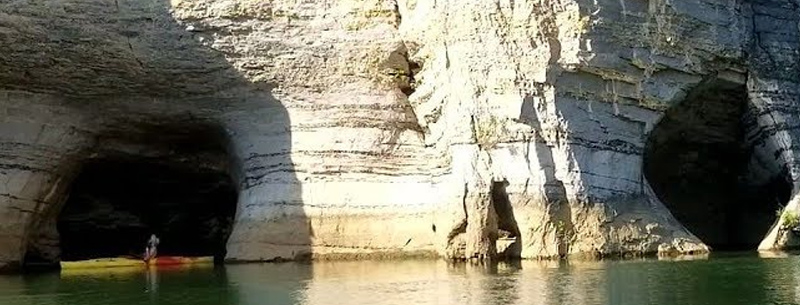Originating high in the Boston Mountains, the Buffalo River drops steadily past towering, multi-colored cliffs, some reaching as high as 400 feet. The river travels for 150 miles until it merges with the White River. In 1972, Congress designated the Buffalo River as America’s First National River. As a result, it has remained free-flowing and unpolluted, an unfortunate rarity these days.
The Buffalo River offers active outdoor activities, including canoeing, fishing, swimming, and hiking. It is a place where a visitor can get glimpses of an earlier way of life, whether that is seeing examples of prehistoric Ozark Bluff Dweller cultures or pioneer homesteads in beautifully scenic, rugged landscape. Three designated wilderness areas allow visitors opportunities for solitude and remoteness as they hike or float.
Buffalo River Trivia
The hills and valleys of the Buffalo River have been home to generations of mountain peoples. The historic permanent settlement started in the late 1820s. Settlers cleared land for pastures and homes, built communities, witnessed the conflict of the Civil War, were part of population shifts and migrations, and experimented with industry to provide for themselves and the region. Many historic homesteads bear testimony to this pioneer life.
The area contains a diversity of the natural reserves that are highly representative of the Ozarks. Known as a biological crossroads of northern and southern connections, many plant and animal species of the Southwest, Northeast, and Southeast co-exist in the Ozarks. Armadillos, roadrunners, and tarantulas live with lichens characteristic of the arctic tundra. More than 60 species of fish live in the Buffalo, and more than 1,500 plant species are found here. More than400 elk are thriving in the forest and clearings of this area after a 1981 re-introduction program brought these animals from the Rockies.
Caves within Buffalo National River provide a fragile habitat for an array of sensitive creatures. There are 340 known caves, including the longest in the state of Arkansas. Twelve species of bats are found in the park, with three of these species on the endangered list.
Buffalo River Attractions
- One hundred thirty-five miles of inviting water provide stretches of rapids and lazy pools for floating. Bring your own canoe or rent one from any of the 14 canoe vendors. Fishing guides are also available.
- Explore the Lost Valley. A short 2.1-mile round trip trail takes you to waterfalls, towering cliffs, a large bluff shelter, a natural bridge, and a cave that can be explored.
- Wildflowers can be enjoyed in season.
- Public cabins located at Buffalo Point and constructed in the 1930s can be rented for in-park accommodations in a rustic setting.
- Thirteen campgrounds spanning the length of the park are available, but only one takes reservations.
- Visit the Parker-Hickman farmstead, Collier Homestead, Rush Mining District, and the Indian Rockhouse shelter for glimpses of early pioneer settlement, industry, and prehistoric occupation.
